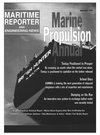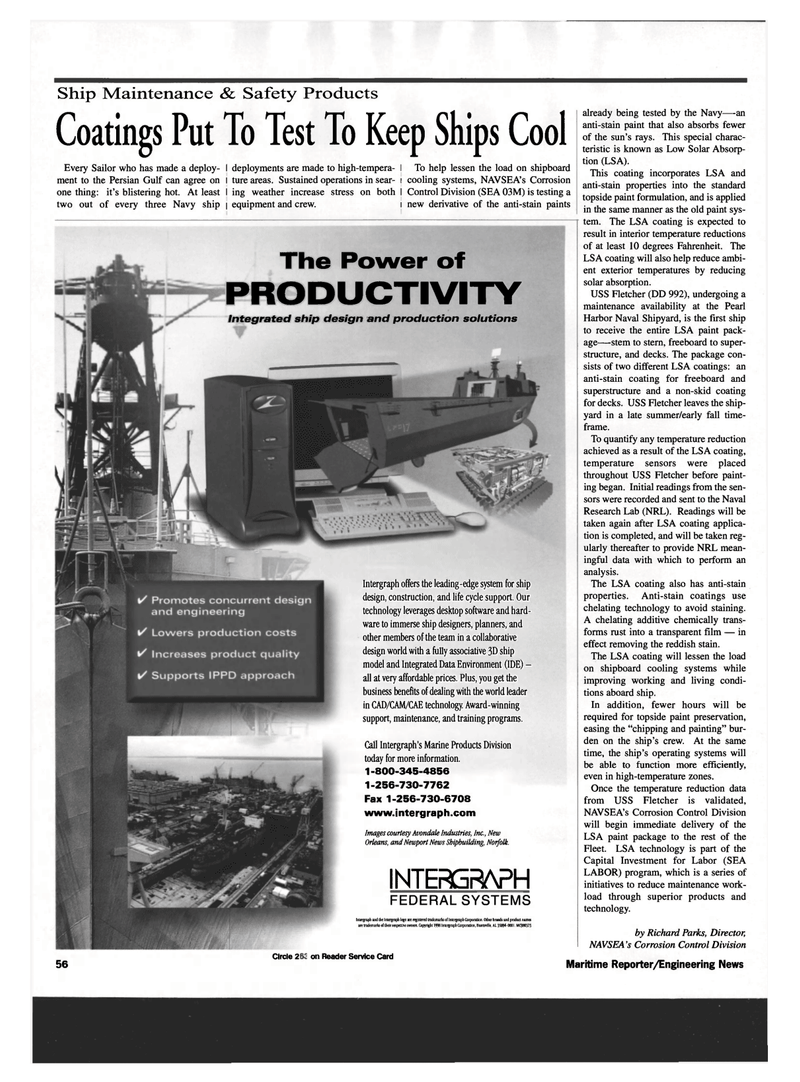
Page 58: of Maritime Reporter Magazine (September 1999)
Read this page in Pdf, Flash or Html5 edition of September 1999 Maritime Reporter Magazine
Ship Maintenance & Safety Products
Coatings Put To Test To Keep Ships Cool
Every Sailor who has made a deploy- deployments are made to high-tempera- To help lessen the load on shipboard ment to the Persian Gulf can agree on ture areas. Sustained operations in sear- cooling systems, NAVSEA's Corrosion one thing: it's blistering hot. At least ing weather increase stress on both Control Division (SEA 03M) is testing a two out of every three Navy ship equipment and crew. new derivative of the anti-stain paints
The Power of
PRODUCTIVITY
Integrated ship design and production solutions
Intergraph offers the leading-edge system for ship design, construction, and life cycle support. Our technology leverages desktop software and hard- ware to immerse ship designers, planners, and other members of the team in a collaborative design world with a fully associative 3D ship model and Integrated Data Environment (IDE) - all at very affordable prices. Plus, you get the business benefits of dealing with the world leader in CAD/CAM/CAE technology Award-winning support, maintenance, and training programs.
Call Intergraph's Marine Products Division today for more information. 1-800-345-4856 1-256-730-7762
Fax 1-256-730-6708 www.intergraph.com
Images courtesy Avondale Industries, Inc., New
Orleans, and Newport News Shipbuilding, Norfolk.
INTERGRAPH
FEDERAL SYSTEMS
Intergraph and the Intergraph logo are registered trademarks of Intergraph Corporation. Other brands and product names are trademarks of their respective owners. Copyright 1998 Intergraph Corporation, Huntsville, AL 35894-0001. MC980373 56 Circle 271 on Reader Service Card already being tested by the Navy—an anti-stain paint that also absorbs fewer of the sun's rays. This special charac- teristic is known as Low Solar Absorp- tion (LSA).
This coating incorporates LSA and anti-stain properties into the standard topside paint formulation, and is applied in the same manner as the old paint sys- tem. The LSA coating is expected to result in interior temperature reductions of at least 10 degrees Fahrenheit. The
LSA coating will also help reduce ambi- ent exterior temperatures by reducing solar absorption.
USS Fletcher (DD 992), undergoing a maintenance availability at the Pearl
Harbor Naval Shipyard, is the first ship to receive the entire LSA paint pack- age—-stem to stern, freeboard to super- structure, and decks. The package con- sists of two different LSA coatings: an anti-stain coating for freeboard and superstructure and a non-skid coating for decks. USS Fletcher leaves the ship- yard in a late summer/early fall time- frame.
To quantify any temperature reduction achieved as a result of the LSA coating, temperature sensors were placed throughout USS Fletcher before paint- ing began. Initial readings from the sen- sors were recorded and sent to the Naval
Research Lab (NRL). Readings will be taken again after LSA coating applica- tion is completed, and will be taken reg- ularly thereafter to provide NRL mean- ingful data with which to perform an analysis.
The LSA coating also has anti-stain properties. Anti-stain coatings use chelating technology to avoid staining.
A chelating additive chemically trans- forms rust into a transparent film — in effect removing the reddish stain.
The LSA coating will lessen the load on shipboard cooling systems while improving working and living condi- tions aboard ship.
In addition, fewer hours will be required for topside paint preservation, easing the "chipping and painting" bur- den on the ship's crew. At the same time, the ship's operating systems will be able to function more efficiently, even in high-temperature zones.
Once the temperature reduction data from USS Fletcher is validated,
NAVSEA's Corrosion Control Division will begin immediate delivery of the
LSA paint package to the rest of the
Fleet. LSA technology is part of the
Capital Investment for Labor (SEA
LABOR) program, which is a series of initiatives to reduce maintenance work- load through superior products and technology. by Richard Parks, Director,
NAVSEA's Corrosion Control Division
Maritime Reporter/Engineering News

 57
57

 59
59
